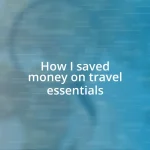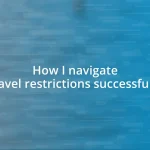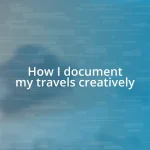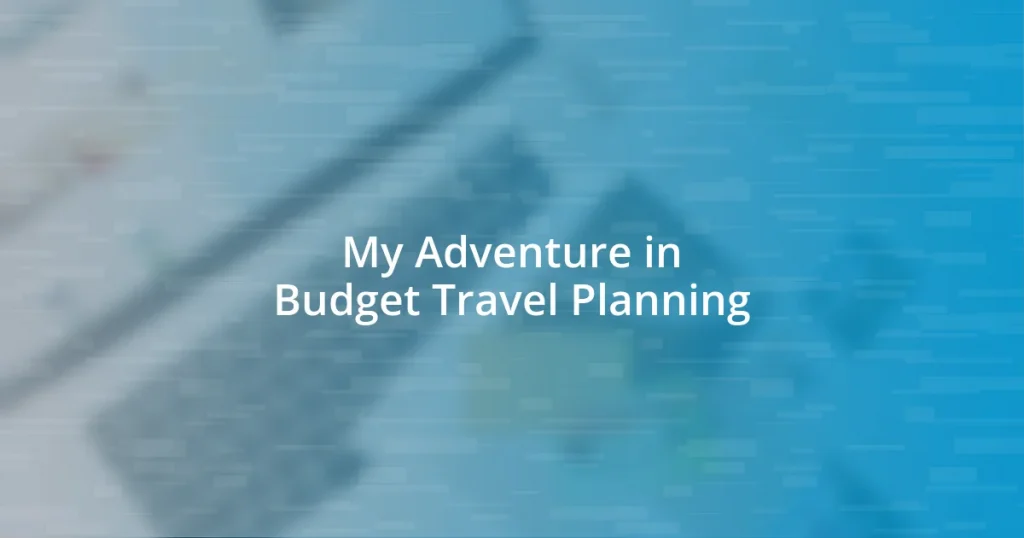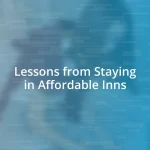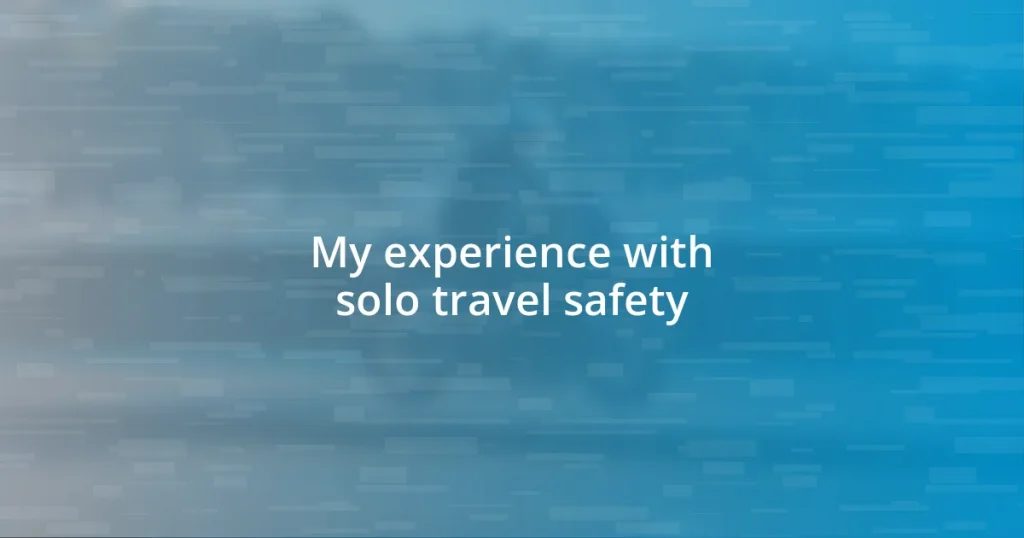Key takeaways:
- Understanding travel priorities, being flexible with plans, and conducting thorough research are essential for effective budget travel.
- Setting a realistic budget involves distinguishing between wants and needs, considering daily expenses, and preparing for emergencies.
- Utilizing public transport, exploring local markets for food, and finding budget-friendly accommodations can significantly enhance the travel experience while saving money.
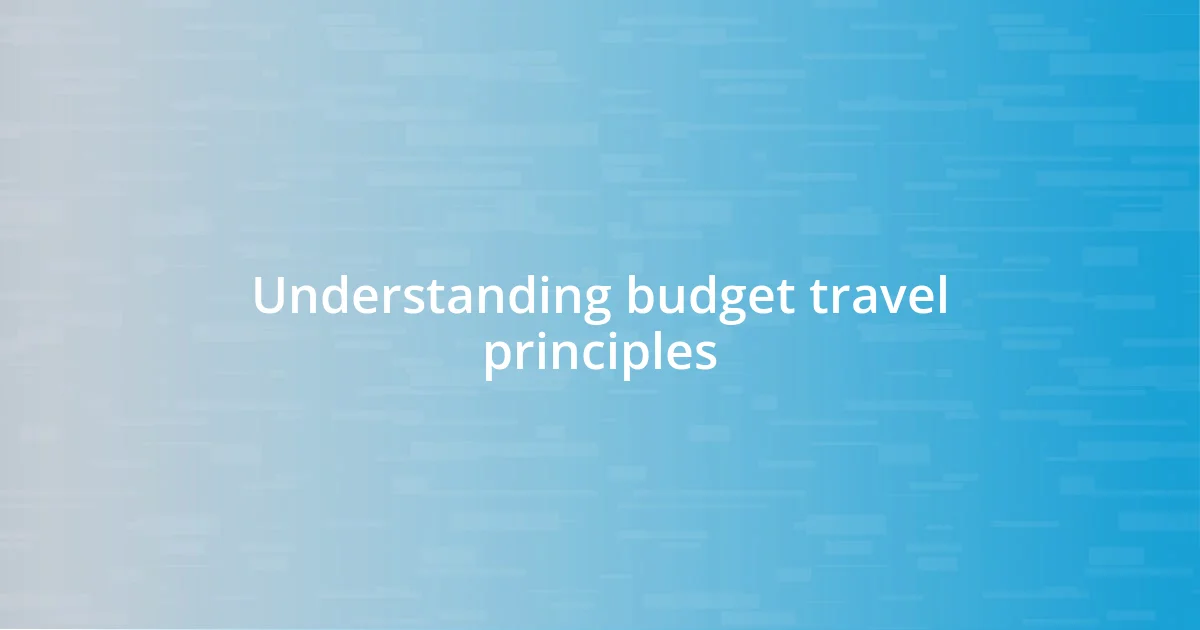
Understanding budget travel principles
When I first dipped my toes into the world of budget travel, I was overwhelmed by the options. I quickly learned that understanding your priorities is key. Are you looking for unique experiences, or is comfort more important? This introspection helps to guide your choices, turning an ambiguous budget into a purposeful travel strategy.
Another principle that became apparent to me early on is flexibility. I remember pricing flights for a trip and realizing that changing my departure date by just a couple of days saved me nearly a hundred dollars. This taught me that being open to adjusting plans can unlock significant savings. Have you ever considered how a minor change could impact your travel costs?
Lastly, I’ve found that thorough research is a game changer. For instance, I once stumbled upon an off-peak festival that was free to enter. It transformed my trip into something unforgettable. Isn’t it exhilarating to discover those hidden gems that can enhance your travel experience without breaking the bank?
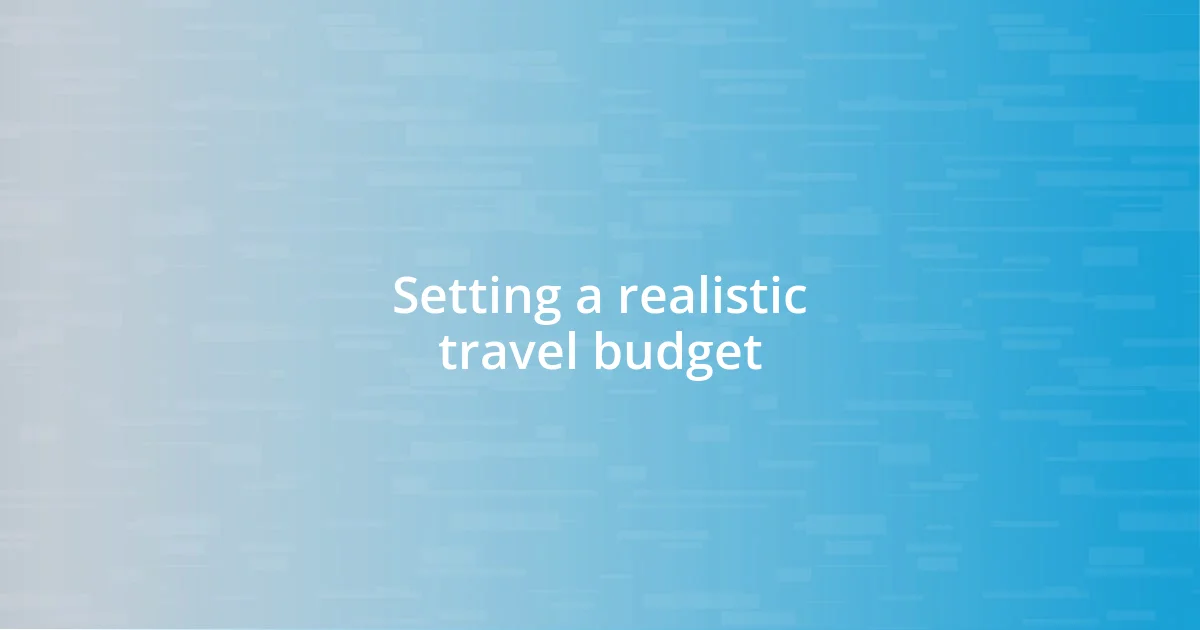
Setting a realistic travel budget
Setting a realistic travel budget requires honest reflection about your financial situation and travel goals. In my experience, it’s crucial to differentiate between wants and needs. I remember planning a trip to Europe and initially budgeting too little for accommodation, which left me either sleeping in questionable hostels or overspending on last-minute hotel bookings. Establishing a clear picture of what your actual expenses will be helps avoid disappointments and financial stress on the road.
To effectively set your travel budget, I recommend considering the following:
– Destination Research: Understand the cost of living in your chosen destination. Some places may seem affordable until you factor in food and activities.
– Daily Expenses: Estimate daily costs, including meals, transportation, and entertainment. This helps pin down a realistic figure that can guide your overall budget.
– Emergency Fund: Set aside a small buffer for unexpected expenses. It’s comforting to know you have a fallback if things don’t go as planned.
– Travel Insurance: Don’t overlook this; it can prevent financial loss in case of cancellations or emergencies.
– Tracking Expenses: Keep tabs on your spending while traveling to avoid overshooting your budget. I often use an app to monitor my daily expenses; it’s a game-changer.
By establishing these elements, you create a framework that supports a memorable and enjoyable trip without the nagging worry of finances.

Researching affordable destinations
Researching affordable destinations is where the adventure really starts. I often find myself scrolling through various travel blogs and forums, hunting for suggestions that align with my budget. One memorable trip was to Thailand, where I read about the stunning islands that are less touristy and, consequently, easier on the wallet. Discovering hidden gems like Koh Lanta, with its affordable beach bungalows, made that experience not just enjoyable, but remarkably budget-friendly.
In my travels, I’ve realized that local culture often dictates pricing. For instance, while researching destinations in Eastern Europe, I was fascinated by how much I could explore without splurging in cities like Budapest or Krakow. I remember a particularly delightful evening spent roaming the streets of Krakow, where I dined at a local eatery for a fraction of what I’d pay elsewhere. The delicious food and authentic ambiance felt like a reward for my budgeting efforts. Have you ever put in the work to find a great deal and ended up with an unforgettable experience?
To make your research easier, I often create a simple comparison table of potential destinations, looking at key factors like cost of living and available activities. This helps me visualize my options and make informed decisions. Here’s an example:
| Destination | Cost of Living ($) | Highlight |
|---|---|---|
| Thailand | Low | Beautiful Beaches |
| Ecuador | Low | Diverse Landscapes |
| Portugal | Moderate | Tasty Cuisine |
| Budapest | Moderate | Thermal Baths |
Using a table like this can simplify the decision-making process and make the research phase less daunting. Each destination has its unique charm and affordability factor, which can cater perfectly to your travel style. Remember, the more you dig into your options, the more chances you have to discover a truly memorable and affordable adventure.
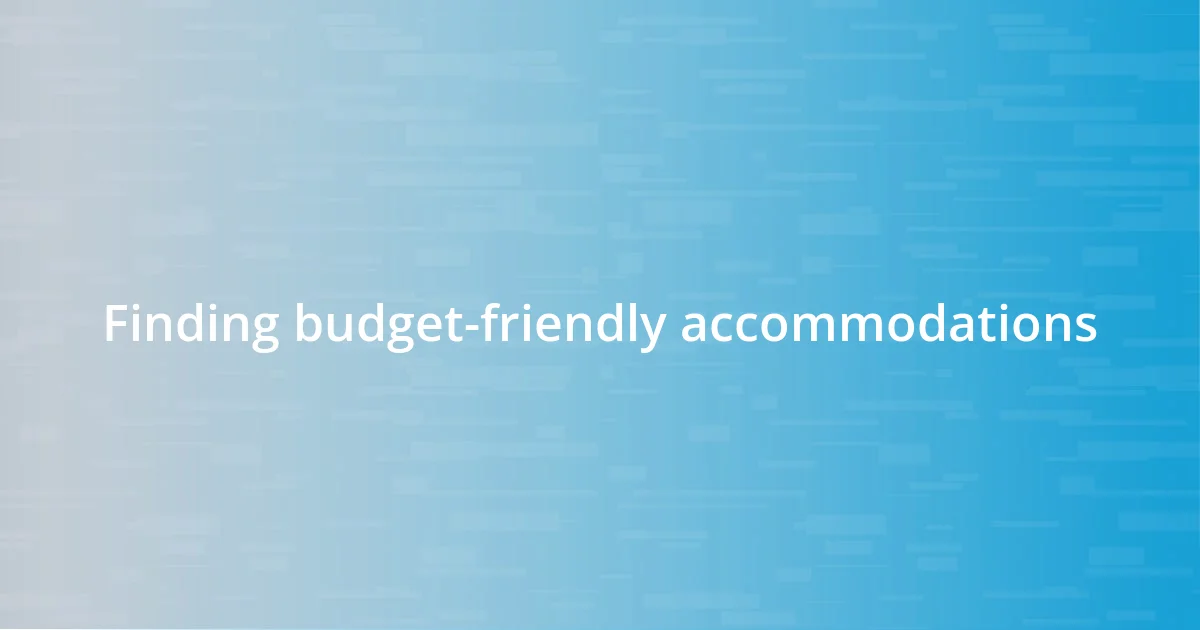
Finding budget-friendly accommodations
Finding the right accommodation without breaking the bank is exhilarating yet challenging. I remember my trip to Indonesia, where I stumbled upon a lovely guesthouse run by a local family. It made my stay not only affordable but also deeply enriching as I got to know the culture through their stories. Have you ever felt that connection with a place simply because of where you chose to stay?
When searching for budget-friendly options, I highly recommend using various booking platforms to compare prices and read reviews. I once came across a beautiful villa on a lesser-known site that offered a fraction of the price compared to bigger booking agencies. The thrill of finding such hidden gems is unmatched—it’s like unearthing a treasure during your travels. Plus, engaging directly with hosts can sometimes land you discounts or special perks that aren’t advertised.
Don’t overlook alternatives like home-sharing or house-sitting opportunities. I’ve found incredible deals by staying with locals who offer spare rooms, providing a unique glimpse into daily life. The last time I did this in Spain, I not only saved money but also made lasting friendships—wasn’t that the best souvenir of all? Exploring these avenues can transform your travel experience while keeping your expenses in check.
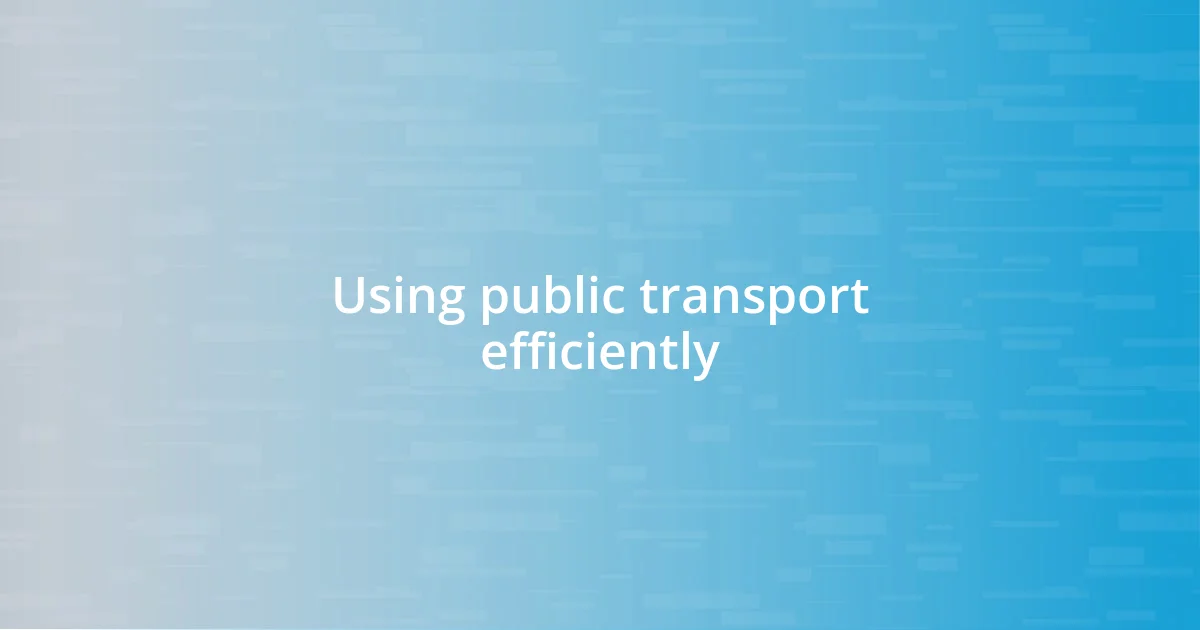
Using public transport efficiently
Using public transport efficiently can completely transform your travel experience. For example, during my time in Japan, I relied heavily on the Japan Rail Pass. It not only saved me a significant amount of money but also allowed me to explore the country’s stunning landscapes at my own pace. I vividly recall hopping on a train in Kyoto, feeling the excitement build as we glided past cherry blossoms—what a joy that was! Have you ever felt the spontaneity of a last-minute train ride lead you to unexpected places?
It’s crucial to familiarize yourself with public transport systems before you embark on your journey. I remember my first experience using the metro in Paris; I downloaded a transit app that helped me navigate the lines and schedules. The moment I figured out how to switch trains seamlessly was empowering. Once you understand the layout, you can delve deeper into cities and uncover hidden corners that aren’t packed with tourists. Does the idea of blending in with locals and discovering their daily routines appeal to you as much as it does to me?
Planning your journeys during off-peak hours can also make for a more pleasant experience. In Barcelona, I discovered that traveling early in the morning allowed me to ride the metro without the crushing crowds. This small adjustment made me appreciate the art and architecture along the way without feeling rushed. When have you found that a slight tweak in your schedule led to a more enjoyable experience on your travels? Embracing public transport not only connects you to the essence of a place but also provides opportunities for memorable moments you might not capture otherwise.

Saving money on food
When it comes to saving money on food while traveling, I’ve found that exploring local markets is an absolute game-changer. On a trip to Thailand, I ventured into a bustling night market and was greeted by an array of colorful dishes and tantalizing smells. The thrill of trying street food for a couple of dollars felt like an authentic culinary adventure—why settle for overpriced restaurant meals when you can feast like a local?
I also make it a point to pack snacks for my day trips. On my last journey through Italy, I filled my bag with fresh fruit and pastries from bakeries I discovered along the way. Not only did it save me money, but it also allowed me to indulge in goodies on the go—who doesn’t love the taste of warm, flaky pastry as you savor the sights? Have you ever realized that a little preparation can enhance your journey in the most delightful way?
Another tip that has served me well is to embrace the local traditions of shared meals. On a memorable evening in Croatia, I joined a dinner at a communal table with other travelers. The host prepared a delicious home-cooked meal using local ingredients, and each dish was not only hearty but very affordable. Sharing food has a way of breaking down barriers and creating connections—how often do we find ourselves bonding over a shared plate?





